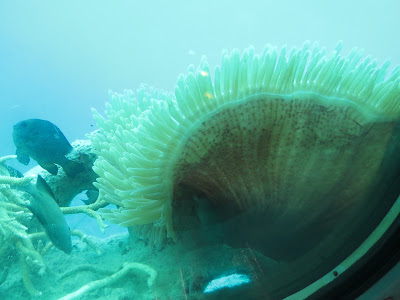Y'all! I am so excited to share my newest article for Mongabay. It's been a bit of hell to write this one. I skimmed many thousands of pages of Environmental Impact Statements, and spent many thousands of Indonesian rupiah on overpriced Starbuck's hot chocolates in Jakarta to hunt down WiFi. But, I think it was all worth it.
In December I flew to the small Pacific island of Guam with my sister, Lisa, to visit her friend from college, Sienna. We had a great time viewing corals from an underwater dome (kind of like an inside-out aquarium), eating delicious CHamoru foods, and admiring cute toads. Photographic evidence below.
 |
| A tropical sea anemone in the family Stichodactylidae. Check out that beautiful symbiotic algae living in its body. |
 |
| A delicious island breakfast of loco moco: white rice topped with hamburger, brown gravy, and fried egg. |
 |
| Lisa and Sienna enjoying the Guam sun. |
 |
| Sienna with noni (Morinda citrifolia) eyeballs. |
 |
| "Star sand" made of foraminifers, a phylum of marine amoeboid protists that produce hard, pointed shells called "tests." |
 |
| Cute, but invasive, cane toad (Rhinella marina). |
Sienna is an exceptional botanist, so I had hoped to learn all about the island's plant life. I ended up learning so much more. Sienna's work to mitigate the deforestation from a massive new military project on Guam caught my attention. It's a tale full of characters, compromise, hope and despair, with biological twists and political turns.
In March, I had my first opportunity to pitch a story of my choice to my editor, Jeremy Hance. The Guam Build-Up and forest "enhancement" was an obvious choice.
Thank you to Lisa, Sienna and the ecosystems of Guam for bringing this story to me and now to all of you!





